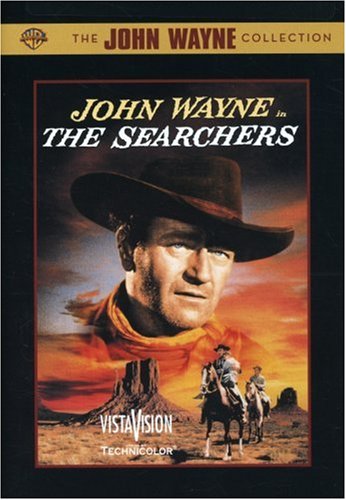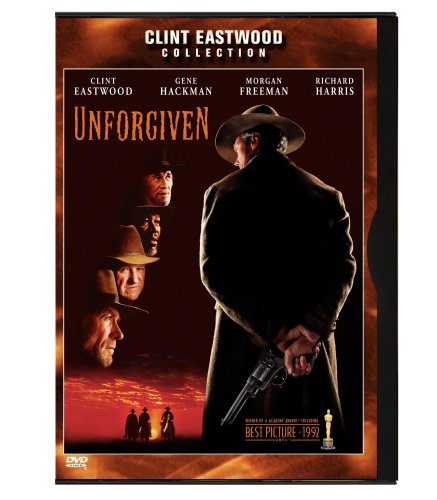Shoe Leather
Jun 23, 2008
Talkin' Western: Language and Rhetoric in the Genre of Endless Vistas by Teri Tynes
"Two letters in one year! By golly!" exclaims Mr. Jorgensen, greeting the letter carrier, Charlie McCorry, who has come to court his daughter, Miss Laurie.
"Two letters in one year! By golly!" exclaims Mr. Jorgensen, greeting the letter carrier, Charlie McCorry, who has come to court his daughter, Miss Laurie. Guitar in hand and bearing a present of "some boiled sweets," the dapper McCorry is poised to make his move. With the arrival of the rare letter, the homesteading pioneer Jorgensens press their daughter into reading out loud the words of her beloved Martin Pawley. The handsome adopted son of their neighbors, Pawley had been absent for many months, all the while searching the dusty desert for little Debbie, a captive of the Comanches, with his Uncle Ethan.
 Moviegoers need little prompting in order to remember how the following scenes unfold in John Ford's epic western, The Searchers (1956). As Laurie begins to read Marty's account of their search for the captive Debbie, the scenes alternate between the domestic interior of the fragile and isolated homestead and the wild exterior beauty of the Monument Valley landscape. Named #1 in AFI's recently announced Top 10 westerns, The Searchers is driven by a complex script that draws on a variety of rhetorical devices as well as by its well-known Ford stock company performances and landscape. The letters, hymns, serenades, and translations bespeak the tenuous hold of words in the Wild West and the efforts to establish literacy in addition to the law. Philosopher Hannah Arendt wrote that violence begins when speech fails, and so in the western, speech serves an integral function in narrative development and closure.
Moviegoers need little prompting in order to remember how the following scenes unfold in John Ford's epic western, The Searchers (1956). As Laurie begins to read Marty's account of their search for the captive Debbie, the scenes alternate between the domestic interior of the fragile and isolated homestead and the wild exterior beauty of the Monument Valley landscape. Named #1 in AFI's recently announced Top 10 westerns, The Searchers is driven by a complex script that draws on a variety of rhetorical devices as well as by its well-known Ford stock company performances and landscape. The letters, hymns, serenades, and translations bespeak the tenuous hold of words in the Wild West and the efforts to establish literacy in addition to the law. Philosopher Hannah Arendt wrote that violence begins when speech fails, and so in the western, speech serves an integral function in narrative development and closure.
Frank S. Nugent, a former reporter for The New York Times and then a script doctor for Darryl F. Zanuck, began working with Ford on Fort Apache (1948) and (1949). In adapting Alan Le May's 1954 novel, She Wore a Yellow RibbonThe Searchers, for the screen, Nugent sharpened the homeric quest in service of the genre and also sprinkled the dialogue with playful and witty humor. Ethan Edwards, the central character played by John Wayne, shows he's a man with a foot in two worlds, often translating words in Spanish and Comanche. His mirror double, Chief Scar, is bilingual, too, able to answer Edwards' wisecrack, "You speak pretty good American for a Comanche. Did someone teach you?" with his own, "You speak good Comanche. Did someone teach you?"
 In the Unforgiven (1992) Clint Eastwood plays reformed gunslinger William Munny, a man who comes out of retirement for one last act of vengeance. David Webb Peoples' screenplay, which he wrote in the late 1970s and picked up later by Eastwood, combines the brutality of violence with spare realistic dialogue. A commentary on the western genre itself, the film features clipped speech, sometimes in simple fragments that refer to everyday acts of "killin'." Only English Bob (Richard Harris) speaks in the puffed-up prose of society, but his language proves an ineffectual and hypocritical affectation. The film’s violent acts are made intentionally uncomfortable and difficult, a departure from the stylized shoot ‘em-ups of the past.
In the Unforgiven (1992) Clint Eastwood plays reformed gunslinger William Munny, a man who comes out of retirement for one last act of vengeance. David Webb Peoples' screenplay, which he wrote in the late 1970s and picked up later by Eastwood, combines the brutality of violence with spare realistic dialogue. A commentary on the western genre itself, the film features clipped speech, sometimes in simple fragments that refer to everyday acts of "killin'." Only English Bob (Richard Harris) speaks in the puffed-up prose of society, but his language proves an ineffectual and hypocritical affectation. The film’s violent acts are made intentionally uncomfortable and difficult, a departure from the stylized shoot ‘em-ups of the past.
 Dead Man (1996), directed and written by Jim Jarmusch, with a cast as diverse as Johnny Depp, Gary Farmer, Crispin Glover, John Hurt, Robert Mitchum, Iggy Pop, and Gabriel Byrne, revels in the language of poetry. Depp plays William Blake, an accountant, who leaves civilization in Cleveland for the western frontier. The Native named "Nobody," played by Farmer, thinks the midwestern accountant is the English poet of the same name, and the development of Depp’s character involves the process of becoming a person who could give voice to the poet’s consciousness.
Dead Man (1996), directed and written by Jim Jarmusch, with a cast as diverse as Johnny Depp, Gary Farmer, Crispin Glover, John Hurt, Robert Mitchum, Iggy Pop, and Gabriel Byrne, revels in the language of poetry. Depp plays William Blake, an accountant, who leaves civilization in Cleveland for the western frontier. The Native named "Nobody," played by Farmer, thinks the midwestern accountant is the English poet of the same name, and the development of Depp’s character involves the process of becoming a person who could give voice to the poet’s consciousness.
Lone Star (1996), John Sayles' political and inter-racial western murder story, set on the Texas-US border, invokes the rhetoric of the real and imagined past. Sayles, who has described the film as not just about the specific geographical boundary but about borders in general, a place where the crossing leads to painful knowledge, crafts a multi-cultural lesson in the personal uses of history. Filmed in Super 35mm to enhance the flat horizontal border, Lone Star borrows imagery directly from the film The Alamo (1960), an important symbol within the film for interpretation. The screenplay incorporates both English and Spanish dialogue, accentuating the crossing of linguistic and cultural boundaries.
The vast territory of the US-Mexican border currently rivals Monument Valley as a western landscape, largely due to the increasing importance of immigration in the national discourse but also because novelist Cormac McCarthy has made it his country. An acknowledged master of contemporary literature, McCarthy has established in this edge of the Chihuahuan desert the template for the classic western. In a place where civilized society has only a tenuous hold, his protagonists roam among the creosote and agave in a seemingly endless and frequently futile search. McCarthy’s language, adapted by Ted Tally for All the Pretty Horses (2000) and the Coen Brothers for No Country for Old Men (2007), soars above the vast landscape, capturing dreams, the stars, and the chasing of the moon. Tommy Lee Jones, with his gritty western demeanor and nuanced subtle performance, conveys McCarthy's prose in an offhanded conversational manner. Jones, a Texas native and the heir apparent to Wayne, also plays the role of the grandfather in Ron Howard's The Missing, a movie directly inspired by The Searchers.
Recent films such as Brokeback Mountain (2005), based on Annie Proulx’s short story, 3:10 to Yuma (2007), and The Assassination of Jesse James by the Coward Robert Ford (2007) stand in evidence of the western genre’s ability to reinvent itself. But as we’re talkin’ westerns, David Milch’s writing for Deadwood (2004), with its elaborate Victorian syntax and rhythmic profanity, especially in the character of Al Swearengen, finds few peers.